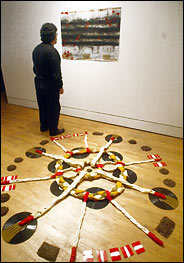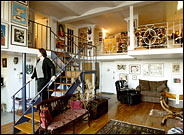|
 |
|
Esta página no está disponible en español. THE NEW YORK TIMESA Puerto Rican Rebirth In El BarrioBy JOSEPH BERGER
December 10, 2002
The Taller Boricua Gallery on 106th Street displays contemporary Puerto Rican art. Librado Romero/The New York Times ---------- Puerto Rican professionals, artists and intellectuals who grew up on the streets of East Harlem but moved away during the years when housing abandonment and drug selling were rampant, are now returning, pumping new life into the neighborhood they call El Barrio. They are sprucing up once-decaying buildings and enlivening the area's cultural life with art galleries. Town houses and apartment buildings are blossoming where there were empty lots. As a result, voguish restaurants and cafes have popped up, including La Fonda Boricua, Dinerbar and SpaHa (a SoHo-like coinage for Spanish Harlem). Their movement, the returnees say, is a philosophical crusade to keep Spanish Harlem the Puerto Rican heartland in the United States. "Puerto Ricans are coming back to the neighborhood," said Dylcia Pagán, a Puerto Rican nationalist who grew up on 110th Street and works for a technology company in San Juan, but was in the neighborhood recently and looked at a brownstone to buy. "Many of us got our education, got better jobs and now are saying we want to come back to our community," she said. These Puerto Ricans are the vanguard of a wider gentrification that is changing the face of East Harlem just as it has changed Harlem to the west. Whites and Asians, mostly young singles, are crossing the once Berlin-Wall-like demarcation of East 96th Street and taking up apartments next to housing projects and bodegas, drawn by prices much cheaper than elsewhere in Manhattan. Residents say they have heard brokers casually speak of their neighborhood as the Upper Upper East Side or Upper Yorkville. Reflecting the new realities, the commission redrawing the City Council lines has pushed the proposed boundary of Councilwoman Eva S. Moskowitz's district on the East Side three blocks north to 99th Street. As a result of wealthier newcomers, the neighborhood's median household income climbed almost 10 percent, to $22,110 in 2000 from $20,110 in 1990. Most significantly, the median income for Hispanics grew by almost 18 percent to $18,313. Like many Puerto Rican strivers, David and Betty Cutié left the clamorous streets of Spanish Harlem for the suburbs 15 years ago, settling in a split-level ranch in Rockland County. But when their daughter Nina was grown and they were thinking about retirement, the Cutiés – David was a principal, Betty a guidance counselor – realized they missed their old neighborhood's sounds and smells. One year ago, they moved back, fixing up a brownstone on East 118th Street and finding that the streets retained much of the gritty, festive mix they cherished: gaudy murals, coconut-ice vendors, sidewalk domino players, hole-in-the-wall luncheonettes with incessant salsa beats, ragged tenements next to fussed-over gardens. But now it was on an upswing, with much less of the crime and drug dealing that had driven them out. ---------- Nicholasa Mohr, a writer, grew up in the East Harlem of the 1940's and returned last year to live there. "This was the capital, the heart of the Puerto Rican community," she said. Librado Romero/The New York Times ---------- They also saw a neighborhood that was rapidly losing the accent and influence that had defined it. "We felt the neighborhood needed us, that we had things we could contribute," said Mr. Cutié, who is on Community Board 11 in East Harlem. Despite the reverse migration, census figures suggest that Puerto Ricans continue to leave for leafier quarters in New Jersey or Queens, just as Italians and Jews left their ghettos when they acquired college educations and better-paying jobs. During the 1990's, the number of Puerto Ricans in East Harlem dropped to 34,626 from 42,816. They were often replaced by Mexicans and Dominicans seeking their fortune in the city. Indeed, East Harlem appears to have experienced a significant shift in the 1990's. The number of non-Hispanic whites grew to 8,377 from 6,952, and the Asian population to 3,278 from 1,512, and by all accounts these numbers are still rising sharply. The city has helped things along; since 1986, it has sponsored the construction or rehabilitation of 8,310 homes and started work on 1,373 more. But in revitalizing the neighborhood, the new Puerto Rican settlers admit that gentrification is raising rents, with two-bedroom apartments that might have been had a few years ago for $600 a month going for $2,200 today. Prosperity has meant jobs and the flowering of local shops, but community leaders worry that low-wage earners will be driven out. "You have a community here that on many fronts is feeling threatened," said Félix V. Matos Rodríguez, director of the Center for Puerto Rican Studies at Hunter College. Fernando Salicrup, director of the Taller Boricua Gallery on 106th Street, which is filled with contemporary Puerto Rican art, said the neighborhood now has more than 1,000 artists and theater people. Nicholasa Mohr, a writer, grew up in the East Harlem of the 1940's, though her family moved to the South Bronx when she was 8. "This was the capital, the heart of the Puerto Rican community," she said. The epicenter of the movement is 106th Street, a corridor that roughly connects several pivotal institutions, including El Museo del Barrio on Fifth Avenue and the Julia de Burgos Cultural Center on Lexington Avenue, which houses the Taller Boricua Gallery. The usual question raised about gentrification is whether it will so prettify the neighborhood that the very flavors that drew people will fade. But Mr. Salicrup, the gallery director, is not worried. "What protects this area are the housing projects," he said. "If you're thinking of moving to El Barrio, you might end up with a project next to you. So the poor are always going to be there."
|

 ----------
----------